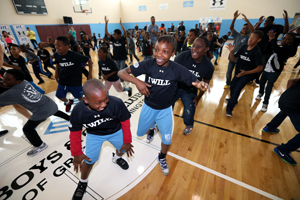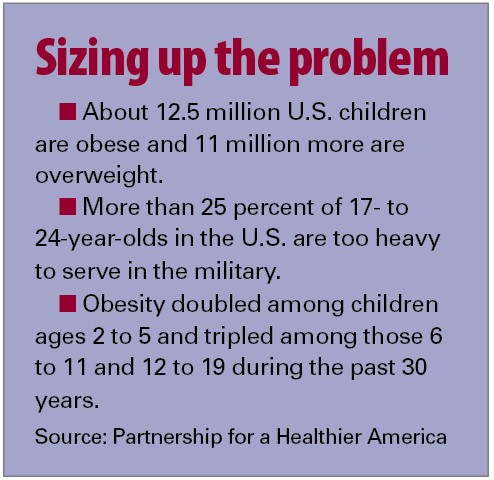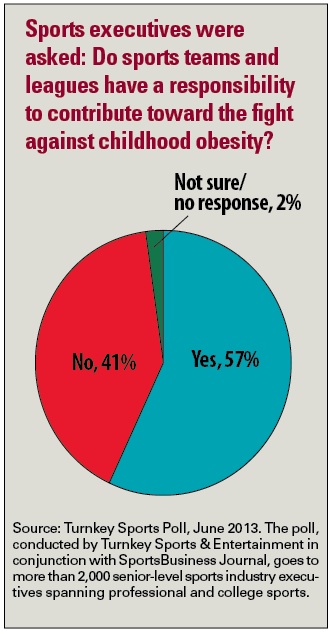Let’s Move. Play 60. NBA Fit. From the first lady to the best-known sports leagues and beyond, everyone wants to get children off the couch and, well, moving.
Childhood obesity and sedentary habits have become epidemics in the United States. During the past 30 years, childhood obesity has tripled to 18 percent, said Michael Gray, an exercise expert and longtime executive board member at the National Alliance for Youth Sports.
 |
Children play during an NBA/WNBA Fit court dedication in May at a Boys and Girls Club in Washington, D.C.
Photo by: NBAE / Getty Images |
Gray, after decades of trying to reverse the trends of poor nutrition and lack of exercise, sees the campaigns by high-profile leagues, teams, athletes and equipment companies as a mixed blessing.
“I like them because at least they’re showing people the need for activity,” Gray said. “But when you look at the statistics, kids are getting fatter. I think it comes down to mom and dad.”
The NFL started Play 60 in 2007 with the mission of getting children to play an hour each day. Peter O’Reilly, NFL vice president of fan strategy and marketing, said the original goal was to reverse childhood obesity by 2015.
“That is the next checkpoint,” O’Reilly said, referring to a partnership with The Cooper Institute, a preventive care research and education nonprofit. NFL Foundation grants totaling $4 million are paying for programs and studies in schools to figure out what works best when it comes to making children healthier.
Greg Welk, an Iowa State exercise and public health professor, is working with the NFL and Play 60. He also leads
FitnessGram, a Cooper Institute program used in schools to assess children’s physical health.
“We’re not focused on obesity and weight loss,” Welk said. “The real epidemic in our society is inactivity. The key point is to be fit.”
Experts and sports executives working on the obesity and physical fitness programs say they are monitoring and measuring trends, but they are also pragmatic.
Reversing societal problems with a single awareness campaign is unrealistic. Instead, the focus is on incremental gains and long-term focus.
“There is no number target,” said Anna Isaacson, NFL director of community programs. “We’re taking all the data to make sure things are moving in the right direction.”
Those involved in sports-themed health and fitness campaigns say smaller steps in the right direction can help make a dent in what has become an overwhelming problem.
“From our perspective, there is no one way to attack this problem,” said Drew Nannis, chief marketing officer at Washington nonprofit Partnership for a Healthier America. “You double-down. It’s as simple as that. The epidemic does continue.”
Nannis sees some cause for optimism. According to a Robert Wood Johnson Foundation report released last year, Mississippi, the unhealthiest state in the nation, lowered the percentage of overweight or obese children to 37.3 percent in 2011, compared with 43 percent in 2007. Other slight decreases were found in California and in cities including New York and Philadelphia.
Partnership for a Healthier America counts Nike, Reebok, the U.S. Olympic Committee and the U.S. Tennis Association among its sports partnerships.
Play 60 and other campaigns tend to follow a similar formula. Spread the word through public-service ads shown during game broadcasts and other high-profile events. Create local grassroots spin-offs with individual teams and players. Call on league and team sponsors to join the effort, often in partnership with schools and other groups. Help build playgrounds, fields, courts and other places where children can play and exercise in a safe environment.
The NFL and its teams have built 150 playgrounds, fitness trails and refurbished gyms since 2007. Like other sports-driven programs, Play 60 has worked with first lady Michelle Obama to combine exercise, nutrition and the combined star power of her with top players. In 2010, Obama appeared in New Orleans with Saints quarterback Drew Brees to start the season. A Play 60 ad was filmed on the White House lawn with President Barack Obama.
Under Armour and the National Dairy Council also have worked with the league on the campaign.
“Getting the right partners is the way to go,” said Todd Jacobson, NBA senior vice president of social responsibility.
NBA/WNBA Fit was developed with the American College of Sports Medicine and the Nemours Foundation’s KidsHealth.org. It encourages fitness and healthy lifestyles for children and families through programs and events across the country. Current and retired players, coaches and trainers also promote the Fit program, which is showcased during a Live Healthy Week including NBA, WNBA and NBA Development League teams.
The first lady also has worked with the NBA, including invitations to the annual White House Easter Egg Roll.
Partners on the NBA fitness drive include YMCAs, Jewish Community Centers and Boys & Girls Clubs. Jacobson says a leaguewide playground-building campaign is among many examples of trying to make sports and play more inclusive.
Partnership for a Healthier America uses written commitments by partners to target clearly defined goals. The USTA, for example, has promised to invest $1 million in 3,200 new tennis courts, train 12,000 coaches and volunteers to teach the game to children 10 and younger, and donate $150,000 worth of equipment to schools and recreation centers.
In 2012, the USOC, the Paralympics and national governing bodies including USA Gymnastics used the attention of an Olympic year to encourage beginner-level participation in various sports. The groups targeted a combined 1 million children to participate. They met the goal and then some, attracting 2.2 million children to give sports a try.
“It’s the first time we’ve done something on this scale,” said Desiree Filippone, USOC managing director of government relations. Governing bodies came up with their own programs, from track-and-field in-a-box, a kit taken to schools to demonstrate track skills and sports, to Gymnastics Day, where children can be flipped upside down to get a taste of the acrobatics of the sport.
Even if such campaigns involve a fair amount of friendly media glow and self-interest, experts say the message and the spotlight can still help raise awareness. And, perhaps, encourage better habits.
“I’m sure a lot of it’s for [public relations], a good image,” said Gray, the youth sports alliance board member. “I think [the leagues and players] are doing a lot. It’s out there all the time.”
Erik Spanberg writes for the Charlotte Business Journal, an affiliated publication.







